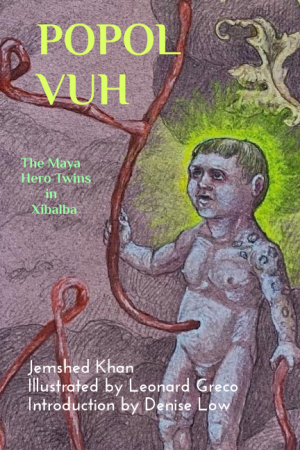
Popol Vuh
The Maya Hero Twins in Xibalba
Popol Vuh is an immersive, inventive reinterpretation of a Mayan creation myth.
Jemshed Khan reengages the Mayan creation myth Popol Vuh by reimagining the Hero Twins and their tumultuous time in the underworld.
Complemented by surreal images, this book is a work of layered narrative poetry in which the past and present coexist. In contemporary times, a thirteen-year-old (modeled after Khan) in an oil town along the Persian Gulf finds a scepter with a replicated Mayan carving on it. The discovery sparks a lifelong interest in Mayan culture, seen in poems like “Kukulcan 1982,” in which a guard is bribed to allow Khan entrance to the grounds of the pyramid at Chichén Itzá. There, he imagines Mayan warriors superimposed over the present and hears “their spirits ask, // Who shall journey to the underworld / and raise us from the dead? / Who will fight for this sacred land?” Indeed, the serendipity and synchronicity of the boy finding the scepter becomes a part of the power and mythos of the Popol Vuh itself.
The book’s interpretation of the Mayan creation myth is quite direct, and it centers the book most. In it, the Hero Twins—born of Maiden Lady Blood and a slain warrior whose decapitated head merged with a dead calabash tree and brought it back to life—are brash and crafty. They trick their grandmother into believing they are farming but instead play pokolpok, a Mayan ball game. When a bid for a competition on the court comes from the Underworld, the arrogant twins rush to follow the owls, convinced they will beat Lord One Death and take revenge. Unimagined perils await them instead, though their relationship helps them survive.
The poems related to the creation myth are character focused; though tying into hero and villain archetypes, they build on the sympathetic connection between the twins and the ways their relationship strengthens them. They possess warrior skills and fantastical magic. In active scenes, they name each of the seven lords of the underworld and survive beheading. Through it all, they maintain faith in each other and the plans they have hatched.
Most of the poems articulate a particular trial, and the short lines and vivid descriptions have an immersive quality. In surreal settings, flora and fauna are lethal and insects act as informants and assassins. In one poem, a twin manifests mosquitoes from a single leg hair; in another, “screeching snatch-bats / careen through the pitch dark, / ready to tear the boys apart.” Musicality is achieved via subtle rhymes and rhythms.
The twins’ trials conclude with a strange, breathless series of tumbling actions, wherein reversals of fortunes abound. And the book’s final section catapults forward to 1520, when the Mayan culture starts to fall to the Spanish and the Day Keeper works in silence and secret to keep his culture alive, reflecting the timelessness of the central tale: “Our books burned, / our temples looted, / gods transmuted, / but fire and pox / do not silence us.”
This personalized, playful retelling of Popol Vuh, a cultural touchstone, reinterprets the Hero Twins’ rollicking descent into the underworld.
Reviewed by
Camille-Yvette Welsch
Disclosure: This article is not an endorsement, but a review. The publisher of this book provided free copies of the book and paid a small fee to have their book reviewed by a professional reviewer. Foreword Reviews and Clarion Reviews make no guarantee that the publisher will receive a positive review. Foreword Magazine, Inc. is disclosing this in accordance with the Federal Trade Commission’s 16 CFR, Part 255.
